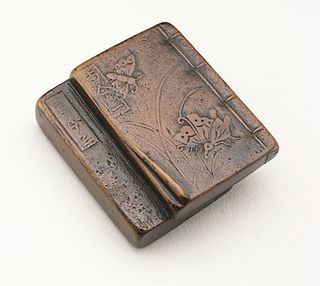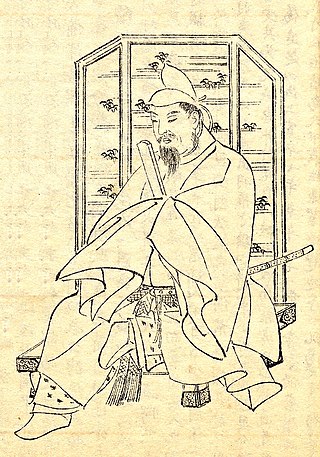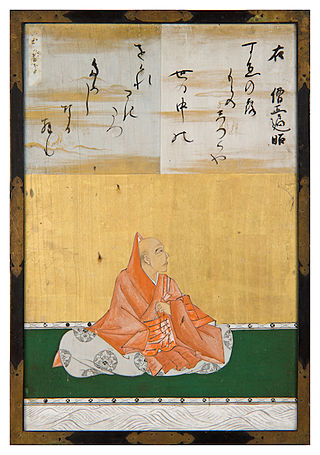Related Research Articles

The Kokin Wakashū, commonly abbreviated as Kokinshū (古今集), is an early anthology of the waka form of Japanese poetry, dating from the Heian period. An imperial anthology, it was conceived by Emperor Uda and published by order of his son Emperor Daigo in about 905. Its finished form dates to c. 920, though according to several historical accounts the last poem was added to the collection in 914.

Ki no Tsurayuki was a Japanese author, poet and court noble of the Heian period. He is best known as the principal compiler of the Kokin Wakashū, also writing its Japanese Preface, and as a possible author of the Tosa Diary, although this was published anonymously. He is well known for his waka poetry and is counted as one of the Thirty-six Poetry Immortals selected by Fujiwara no Kintō; his poetry was included also in the Hyakunin Isshu. As a courtier, he served as Governor of Tosa (930-935), Vice Governor of Kaga (917-923) and Vice Governor of Mino Province (918-923).
The Shin Kokin Wakashū, also known in abbreviated form as the Shin Kokinshū (新古今集) or even conversationally as the Shin Kokin, is the eighth imperial anthology of waka poetry compiled by the Japanese court, beginning with the Kokin Wakashū circa 905 and ending with the Shinshokukokin Wakashū circa 1439. The name can be literally translated as "New Collection of Ancient and Modern Poems" and bears an intentional resemblance to that of the first anthology. Together with the Man'yōshū and the Kokinshū, the Shin Kokinshū is widely considered to be one of the three most influential poetic anthologies in Japanese literary history. It was commissioned in 1201 by the retired emperor Go-Toba, who established a new Bureau of Poetry at his Nijō palace with eleven Fellows, headed by Fujiwara no Yoshitsune, for the purpose of conducting poetry contests and compiling the anthology. Despite its emphasis on contemporary poets, the Shin Kokinshū covered a broader range of poetic ages than the Kokinshū, including ancient poems that the editors of the first anthology had deliberately excluded. It was officially presented in 1205, on the 300th anniversary of the completion of the Kokinshū.

Japanese poetry is poetry typical of Japan, or written, spoken, or chanted in the Japanese language, which includes Old Japanese, Early Middle Japanese, Late Middle Japanese, and Modern Japanese, as well as poetry in Japan which was written in the Chinese language or ryūka from the Okinawa Islands: it is possible to make a more accurate distinction between Japanese poetry written in Japan or by Japanese people in other languages versus that written in the Japanese language by speaking of Japanese-language poetry. Much of the literary record of Japanese poetry begins when Japanese poets encountered Chinese poetry during the Tang dynasty. Under the influence of the Chinese poets of this era Japanese began to compose poetry in Chinese kanshi); and, as part of this tradition, poetry in Japan tended to be intimately associated with pictorial painting, partly because of the influence of Chinese arts, and the tradition of the use of ink and brush for both writing and drawing. It took several hundred years to digest the foreign impact and make it an integral part of Japanese culture and to merge this kanshi poetry into a Japanese language literary tradition, and then later to develop the diversity of unique poetic forms of native poetry, such as waka, haikai, and other more Japanese poetic specialties. For example, in the Tale of Genji both kanshi and waka are frequently mentioned. The history of Japanese poetry goes from an early semi-historical/mythological phase, through the early Old Japanese literature inclusions, just before the Nara period, the Nara period itself, the Heian period, the Kamakura period, and so on, up through the poetically important Edo period and modern times; however, the history of poetry often is different from socio-political history.

Hyakunin Isshu (百人一首) is a classical Japanese anthology of one hundred Japanese waka by one hundred poets. Hyakunin isshu can be translated to "one hundred people, one poem [each]"; it can also refer to the card game of uta-garuta, which uses a deck composed of cards based on the Hyakunin Isshu.

Sugawara no Michizane was a scholar, poet, and politician of the Heian Period of Japan. He is regarded as an excellent poet, particularly in waka and kanshi poetry, and is today revered in Shinto as the god of learning, Tenman-Tenjin. In the poem anthology Hyakunin Isshu, he is known as Kanke (菅家), and in kabuki drama he is known as Kan Shōjō (菅丞相).

Yoshimine no Munesada (良岑宗貞), better known as Henjō, was Japanese waka poet and Buddhist priest. In the poetry anthology Kokin Wakashū, he is listed as one of the six notable waka poets and one of the thirty-six immortals of poetry.

Fujiwara no Shunzei was a Japanese poet, courtier, and Buddhist monk of the late Heian period. He was also known as Fujiwara no Toshinari or Shakua (釈阿) and when younger (1123–67) as Akihiro (顕広). He was noted for his innovations in the waka poetic form and compiling the Senzai Wakashū, the seventh imperial anthology of waka poetry.
Years link to the corresponding "[year] in poetry" articles.
This page is part of the List of years in poetry. The List of years in poetry and List of years in literature provide snapshots of developments in poetry and literature worldwide in a given year, decade or century, and allow easy access to a wide range of Wikipedia articles about movements, writers, works and developments in any timeframe. Please help to build these lists by adding and updating entries as you use them. You can access pages for individual years within the century through the navigational template at the bottom of this page, and you can access pages for other centuries through the navigational template to the right. To access the poetry pages by way of a single chart, please see the Centuries in poetry page or the List of years in poetry page.
Years link to corresponding "[year] in poetry" articles.

Fujiwara no Kintō, also known as Shijō-dainagon, was a Japanese poet, admired by his contemporaries and a court bureaucrat of the Heian period. His father was the regent Fujiwara no Yoritada and his son Fujiwara no Sadayori. An exemplary calligrapher and poet, he is mentioned in works by Murasaki Shikibu, Sei Shōnagon and in a number of other major chronicles and texts.

The Rokkasen are six Japanese poets of the mid-ninth century who were named by Ki no Tsurayuki in the kana and mana prefaces to the poetry anthology Kokin wakashū as notable poets of the generation before its compilers.

Waka is a type of poetry in classical Japanese literature. Although waka in modern Japanese is written as 和歌, in the past it was also written as 倭歌, and a variant name is yamato-uta (大和歌).
Heian literature or Chūko literature refers to Japanese literature of the Heian period, running from 794 to 1185. This article summarizes its history and development.
The chokusen wakashū, also shortened to chokusenshū, were imperially-commissioned Japanese anthologies of waka poetry. They numbered 21 in total.
References
- ↑ Teele, Nicholas J. “Rules for Poetic Elegance. Fujiwara No Kintō’s ‘Shinsen Zuinō’ & ‘Waka Kuhon.’” Monumenta Nipponica, vol. 31, no. 2, 1976, pp. 145–64. JSTOR, https://doi.org/10.2307/2384458. Accessed 22 Dec. 2023.
- ↑ Konishi, Jin’ichi, et al. “Association and Progression: Principles of Integration in Anthologies and Sequences of Japanese Court Poetry, A. D. 900-1350.” Harvard Journal of Asiatic Studies, vol. 21, 1958, pp. 67–127. JSTOR, https://doi.org/10.2307/2718620. Accessed 22 Dec. 2023.
- ↑ McCullough, Helen Craig (1985). Kokin Wakashu: The First Imperial Anthology of Japanese Poetry: With ‘Tosa Nikki’ and ‘Shinsen Waka’. Stanford, CA: Stanford University Press. ISBN 9780804712583.
- ↑ Miner, Earl; H. Odagiri; R. E. Morrell (1985). The Princeton Companion to Classical Japanese Literature . Princeton University Press. pp. 186–187. ISBN 0-691-06599-3.
- ↑ Brower, Robert H.; Earl Roy Miner (1961). Japanese court poetry. Stanford University Press. LCCN 61-10925.
- ↑ Shirane, Haruo (2012-09-25). Traditional Japanese Literature: An Anthology, Beginnings to 1600, Abridged Edition. Columbia University Press. ISBN 978-0-231-50453-9.
- ↑ Richard, Kenneth L. (1983). "Review of The Ten Thousand Leaves. A Translation of the Man'yoshu, Japan's Premier Anthology of Classical Poetry. Volume One.; From the Country of Eight Islands. An Anthology of Japanese Poetry.; The Zen Poems of Ryokan". Pacific Affairs. 56 (1): 157–159. doi:10.2307/2758798. ISSN 0030-851X. JSTOR 2758798.
- ↑ Haruo Shirane. Traces of Dreams: Landscape, Cultural Memory, and the Poetry of Basho. Stanford University Press, 1998. ISBN 0-8047-3099-7